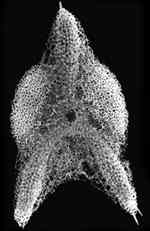


 |
Introduction & Morphology |
 |
Geological Application |
 |
Distribution in Space & Time |
 |
Glossary |
 |
Links |
 |
Home |
| | |
GEOLOGICAL APPLICATION
 Since polycystine radiolarians are well-preserved in the sediments after death, they have been instrumental in their application to paleontological studies. The earliest records of their shells in fossiliferous deposits date back to the Cambrian. Radiolarian fossils in sediments allow a variety of studies, including determinations of the age of the sediments that contain them, analyses of the spatial relationships between sedimentary layers (of particular importance for the oil industry), studies of the geological evolution of the continental land masses and ocean basins, etc. Furthermore, studying the changes in the morphology of radiolarian skeletons through time yields first hand information on the evolution of the group, and on the rates and modes of species formation and extinction. This information can yield important facts pertaining to climatology during a certain time period including the present.
Since polycystine radiolarians are well-preserved in the sediments after death, they have been instrumental in their application to paleontological studies. The earliest records of their shells in fossiliferous deposits date back to the Cambrian. Radiolarian fossils in sediments allow a variety of studies, including determinations of the age of the sediments that contain them, analyses of the spatial relationships between sedimentary layers (of particular importance for the oil industry), studies of the geological evolution of the continental land masses and ocean basins, etc. Furthermore, studying the changes in the morphology of radiolarian skeletons through time yields first hand information on the evolution of the group, and on the rates and modes of species formation and extinction. This information can yield important facts pertaining to climatology during a certain time period including the present.

Page 2